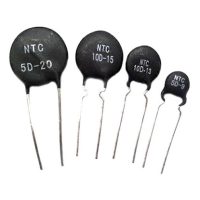Thermistor¶
s A thermistor is a semiconductor device whose resistance depends much more on temperature than standard resistors. The name "thermistor" is derived from "thermal resistor." These devices are widely used for temperature sensing and compensation applications in various electronic circuits and systems.
The resistance-temperature relationship in a thermistor can be highly nonlinear, which means that its resistance changes rapidly with temperature. This nonlinear behavior makes them very sensitive to temperature changes, allowing for precise temperature measurements in a specific range.
Due to their small size, fast response times, and wide range of operating temperatures, thermistors have become essential components in many electronic devices and systems where temperature monitoring and control are critical.
Types of Thermistors¶
Thermistors are typically made of semiconductor materials with a negative temperature coefficient (NTC) or positive temperature coefficient (PTC). The most common type is the NTC thermistor, which exhibits a decrease in resistance as the temperature increases. On the other hand, PTC thermistors have an increasing resistance with an increase in temperature.
NTC¶
The decrease in resistance with temperature is attributed to an increase in conduction electrons bumped up by thermal agitation from the valence band. An NTC is commonly used as a temperature sensor. The behavior is similar to metal-based resistors.

The behavior of NTC thermistors is approximately captured using the β model:
$$R=R_0\exp{b\eta{}\left(\cfrac{1}{T}-\cfrac{1}{T_0}\right)}$$
Where R0 and T0 (in Kelvin) are reference resistance and temperature. Usually, room temperature is taken as one reference po\int. We may need another reading at a different temperature to calculate β.
A more accurate model is the Steinhart-Hart model.
PTC¶
The increase in resistance is attributed to increased thermal lattice agitations, particularly those of impurities and imperfections. PTC thermistors are commonly installed in series with a circuit and used to protect against overcurrent conditions as resettable fuses. The behavior is similar to semiconductor-based resistors. At very high temperatures, the material reverts to NTC behavior.
Symbols of thermistors¶

Steinhart–Hart equation¶
The Steinhart-Hart equation is a mathematical model that describes the resistance-temperature relationship of thermistors. It provides a way to calculate the temperature from the electrical resistance of a thermistor over a wide range of temperatures.
$$\cfrac{1}{T}=A+Bln{R}+C\left(ln{R}\right)^3$$
where A, B, and C are called the Steinhart–Hart parameters and must be specified for each device. T is the absolute temperature, and R is the resistance.
The Steinhart-Hart coefficients are characteristic parameters unique to each thermistor and are determined through calibration. To use the Steinhart-Hart equation, the coefficients for a particular thermistor must be derived. These coefficients can be obtained by measuring the thermistor's resistance at three different known temperatures and then solving for the coefficients using these data points.
The Steinhart-Hart equation provides a more accurate and nonlinear representation of the resistance-temperature relationship than simpler linear approximations. As a result, it is widely used in temperature compensation circuits and systems where precise temperature measurements are required.
Self heating and thermal time constants¶
When electric current flow through the thermistor, the voltage drop across the thermistor, and the current through it dissipates power, which causes an additional change in temperature. This additional change in temperature is not due to external temperature but affects the temperature reading. This change in temperature reading of the thermistor due to power dissipation is called self-heating effect.
To reduce the self-heating effect, it is desired to have a larger surface area of the thermistor. However, with a larger surface area, the time to increase to the stable temperature also increases.
After accounting for its self-heating, the time to reach the stable temperature in a thermistor is called the thermal-time constant. Thermal time constant and self-heating depend strongly on the material property.
Applications¶
Some key characteristics and applications of thermistors include:
-
Temperature Sensing: Thermistors are widely used in thermostats, weather stations, electronic devices, and various industrial applications.
-
Temperature Compensation: They are employed in electronic circuits to compensate for temperature variations that can affect the performance of components, such as in voltage regulators.
-
Temperature Control: Thermistors can be used in temperature control systems to trigger actions like turning on fans or heaters when specific temperature thresholds are reached.
-
Inrush Current Limiting: PTC thermistors are used as inrush current limiters in power supplies to limit the initial current surge during startup.
-
Liquid Level Sensing: In some cases, thermistors can be used for liquid level sensing based on the change in temperature when a liquid comes in contact with the thermistor.
-
Temperature Calibration: Thermistors can calibrate and verify the accuracy of other temperature sensors and instruments.